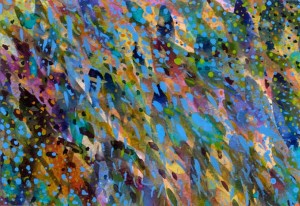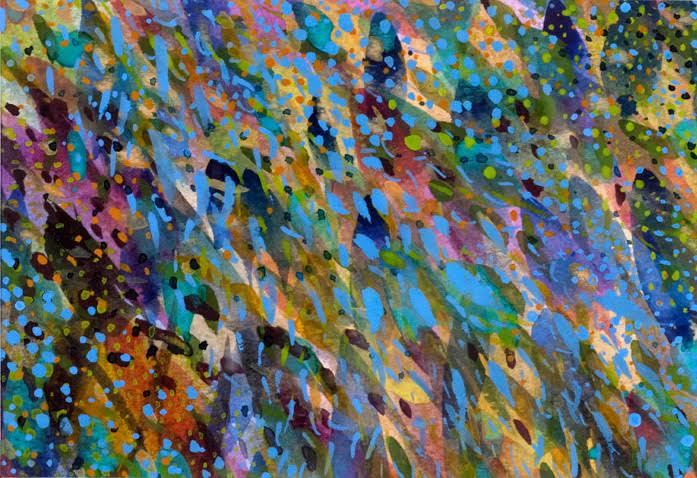By Bart Barry-

Editor’s note: For part 12, please click here.
*
SAN ANTONIO – Very good artists inspire imitation – why so much boxing writing of the 1970s and 1980s looks like stepped-on Hemingway – but great artists inspire others to pursue their craft regardless where it leads. Thursday evening in this city’s irreplaceable McNay Art Museum, as part of a celebration of local artists, painter Stefani Job Spears gave a talk about her abstract paintings and the glorying in color complements and fractals that charges her process that creates them.
And layers – she spoke quite a lot about layers. Many of her watercolors have a hundred layers to them, each layer equal parts mathematically insignificant and aesthetically essential, and this layering effect was one she discovered, in part, by making colored paper, a process through which the fibers in pulp are blended by crushing. Layers consume Spears’ recent work as they consume every artist’s work, often in a proportionality with the artist’s seriousness.
What plagues Spears’ work, or would were she not adamantly opposed to such a plaguing, is what plagues all who obsessively pursue layers: a lack of tension, which resolves itself as muddiness in visual arts and noisiness in music and nervously linked anecdotes in writing. The most painful part: Artistic tension follows a balloon’s model – it is generally greatest, with metaphors stretched to shiny, the instant before it deflates with a pop. Artists abandon works eventually after this deflation happens though never soon enough; they set out to reconcile the sudden lack of tension by rebuilding, relayering, repiling, but such conscientiousness seldom wins the day because the composition grows only looser as the colors muddle, and all the while, crueler still, their memory of the gorgeous tension their works comprised, the wrenching into existence their creation celebrated, now overdyes each forwards gaze they cast at their suddenly unsatisfactory and worsening piece.
How does one know when to stop layering? There are two paths that both reduce, eventually, to luck – for the greatest works of art ever evince chance as much as another quality, and the greatest artists never evince any emotion more than gratitude, profound thankfulness for their fortune – and those paths are: 1. Luck, and 2. Feedback properly observed. The works that endure best, that receive the highest appraisals centuries after their births, are those that impress us as relying least on chance, though there’s a good chance this is our misperception more than any actuality their creators would recognize.
Miguel de Cervantes, we assume, had no chance of getting lucky for two books and 700 pages of Don Quijote, and this is close to true as we’re likely to come. But the genesis of his idea, to take histories purporting to nonfiction and have them drive a reader to a portrayal of delusion – and again, friends, this question is the reason the book endures: Was Quijote delusional, or by inventing a character publicly addled enough for others to play along with him, for their own amusement, did Quijote accomplish a life very near his ideal of one? – probably arrived in a seed owed to good fortune, and besides, anyone who has read or reread El Quijote in English or Spanish can attest to something nearly objective like: If Cervantes got unlucky on hundreds of those pages, so unlucky in his first book, in fact, he spent a couple lucky sentences in book two making fun of his own terrible writing, it is not untoward to suggest his best sentences, too, owed some to chance.
Enough with the tautologies; luck is luck, yes, and? – take us to feedback (which is the feedback). That is what Stefani Job Spears was about in her Thursday discussion when she said she did not allow a work to muddy itself beyond repair, and she did not allow her students to allow their works to muddy themselves beyond repair. She believes and teaches a work must be wrestled back from that muddy brink, and it’s a wonderful technique that saves future works while appearing to save present ones. Knowing one may not abandon a work whose canvas has popped, oozing its tension from electric orange to beige to mahogany, see, makes an artist err just to the restrained side of his next work; the anxiety that leads him to continue adding layers, to continue pursuing a beautiful truth, finds itself moderated by a cultivated anxiety about what destruction one last layer might bring, and here is where a tension begets another tension that amplifies the tension created by two other tensions, and these iterated tensions make a work that endures.
To those who might rebut “Works fail all the time – look at this column,” Spears’ process counterargues: Completed works fail, yes, but a work cannot be a failure till it is completed, and considering works incomplete until they succeed remedies that indeed (a spirally argument more than a circular one). And this brings us to the essence of the approach: Works must only be completed in order to achieve acclaim or revenue; an artist who finds his life’s highest fulfillment in creation’s very process needn’t ever declare a work completed, and therefore mustn’t ever concede failure, even while the ecstatic tension of his creating, feedback’s feedback, continues its accumulation.
Until this column ends, it does not fail.
Bart Barry can be reached via Twitter @bartbarry



























